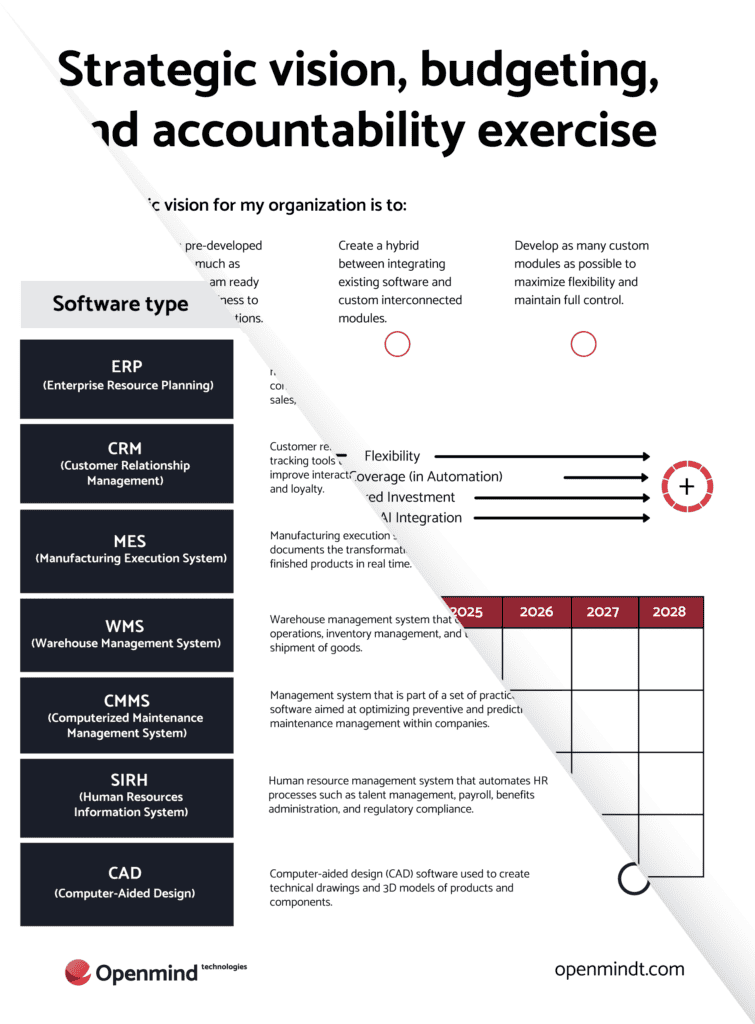Elevate your strategy with key resources
Download our Technological Maturity Self-Assessment & Strategic Vision Exercise tools to assess your software ecosystem profile and to plan for future growth.

Following a study conducted by Raymond Chabot Grant Thorton among 300 leaders of Quebec companies with 10 to 499 employees, 71% of respondents confirmed that market competitiveness is one of their main issues. While some companies manage to succeed by acquiring equipment, adding new products or offering more attractive products than the competition, others have understood the potential of exploiting the Big Data in order to do so.
As explained by Gartner, Big Data is defined as large, high-speed and/or highly diverse information assets that require innovative and cost-effective forms of information processing that enable better understanding, decision-making and process automation.
Those companies that involve technology in their business model have understood the positive impact that Big Data can have on their profitability. Thanks to the ability to quickly exploit a wide variety of data (video, text, images, sound, statistics, etc.) from a multitude of sources (internal company databases, external databases, social networks, surveys, studies, open data, etc.), companies have the ability to better predict market trends and adjust accordingly.
In practice, Big Data becomes a strategic tool that can guide you in your business analysis and customer experience.
Here are a few examples …

Through the analysis of data from various data resources such as: market research, geographical data, CRM tools, connected objects, social networks, competitors’ prices, etc., a company can better compete with the prices offered by the competition.

Thanks to the relationship of the data created by the Big Data, a company can make better decisions and adjust its purchasing cycle according to the predictions provided by the analysis of internal and external data such as: purchasing history, price of materials, exchange rate, economic conditions, etc…

Big Data’s data analysis provides a better understanding of the value customers place on the products and services offered by the company. Data accessible through social media, website visits, call histories, etc., allows the company to use this information to adjust its offering to meet the expectations and requirements of its customers.

Some internal and external data can be processed in order to get the pulse on different aspects that affect your employees: productivity, motivation, commitment to the company, salary, etc… The correlation of these data allows an employer to obtain the information needed to understand the shortcomings of its organization and make the necessary changes to ensure employee loyalty.

VOLUME
Processing large volumes of unstructured, low-density data

VARIETY
Variety refers to the different types of data concerned

SPEED
The speed with which data are received and processed

Download our Technological Maturity Self-Assessment & Strategic Vision Exercise tools to assess your software ecosystem profile and to plan for future growth.

There are many steps that need to be taken before a company can successfully leverage Big Data in its decision-making processes. So it’s normal to be confused about where to start. That’s why it’s best to take it one bite at a time and do it iteratively. Above all, Big Data integration must begin by targeting a use case that can then be tested and adjusted, if necessary, in your environment. Once the process is optimal, it can then be deployed to its full potential within your organization.
For each of the iterations involved in your Big Data strategy, it is recommended that you define the main objective you want to achieve.
During this second step, it is planned to gather all the data that will be necessary for the realization of your Big Data project. This data can come mainly from your management system (CRM, ERP, purchasing, production), however, your Big Data project can also be optimized with external information from sources such as: connected objects, open data, social networks, surveys, etc. To do so, it is possible to integrate an application programming interface (API) capable of connecting this information to each other, which will allow you to get a better overview of the achievement of your objectives.
Once you have targeted all the data resources needed for your Big Data project, the acquisition of a technological tool dedicated to mixed data processing is strongly recommended. For a low volume processing volume, there are OpenSource solutions such as NoSQL that can manage structured and semi-structured data, such as MongoDB. This information storage solution is accessible because it can be operated from the company’s server or from a low cost cloud computing server. However, in the event of the need to process a very important quantity of data in real time or large data due to their size (images, videos, etc.), the use of advanced and dedicated solutions becomes a must.
Companies that are going digital are definitely making it easier for them to use Big Data as part of their business strategy. In order for Big Data to be used to its full potential, it becomes necessary to acquire a solution that will suit the reality and needs of your business.
The species that survive are not the strongest, nor the most intelligent, but those that best adapt to change. Charles Darwin
A company that can intelligently integrate Big Data’s processes into its business vision will be able to adapt to this technological revolution and thus better seize the growth opportunities offered by this 4th industrial revolution.
For more insights on managing data effectively, check out our article: Ensuring Data Integrity During Data Migration: A Guide for Business Leaders. This guide provides essential strategies to maintain data accuracy and consistency during the migration process, helping you avoid common pitfalls and ensure a smooth transition.
Subscribe to receive our exclusive updates directly to your email.

Tell us more about your needs so that we can better route your project to our specific SWAT team.
1
During the brainstorming phase, we work with you to identify potential solutions to your business challenges to generate the technology response that aligns with your business objectives.
2
Through our requirements gathering process, we work closely with you to define and prioritize your needs, ensuring that our solutions are tailored to meet your specific requirements.
3
This phase marks the beginning of our partnership. We’ll finalize the project plan and establish clear communication channels to ensure a smooth and successful project execution.